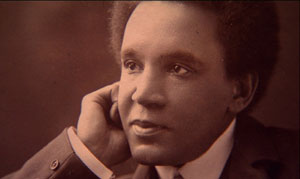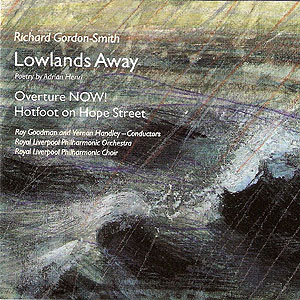|
|

Richard writes about his commission to mark the Centenary of the death of Samuel Coleridge-Taylor and the event at the National Portrait Gallery
held in November 2012...

Lowlands Away
The tragic true story of the loss at sea in 1895 of the composer's great grandfather and a bottle message (with poems by the distinguished Merseyside poet Adrian Henri) earned Richard the coveted Merseyside Arts and Entertainment Award 1996.
The CD is available | HERE |
"No audience can remain unmoved by this masterly composition"
Liverpool Echo
|
Richard's Blog...
Why would a composer want to write a novel?
I don’t know how many novels I have read in my life – certainly thousands – in fact for over half a century there has never been a time when I have not had at least one novel ‘on the go’. I know I am not alone in this and, alongside works of music, poetry and drama, the novel is a form for which I have great respect. I would argue that historically it has been the play and the novel that have defined and in some cases promoted change in society, developed our image of ourselves as civilised creatures and created an essential internal narrative for understanding the vicissitudes of the age in which they were penned.
You can find out why in full HERE
RG-S
May 2016 |
Richard was recently interviewed.
Jennifer: How do you prepare a composition? Do you sketch ideas or use another technique?
Richard: The starting point and first steps in a composition depend on a variety of factors. If the piece is commissioned, the commissioners will nearly always give some sort of parameters in which to work ....
You can read the interview in full HERE
RG-S
September 2012 |
Memories of ‘Hiawatha’
Inherited nostalgia from the RAH Hiawathas
In the very class conscious 20s and 30s [by today's standards] my father's parents would have been considered 'lower middle class'. Their cultural aspirations included occasional theatre and concert attendance, musical evenings in their home for friends, participation in amateur operatic performances and the acquisition of moderately good antiques. Their attendance at the Royal Albert Hall during the 1924 - 1939 period was probably not a frequent event, but Hiawatha was something that everyone went to, so they duly 'feathered up' with their friends and joined the thousands on the train to Kensington. 1929 onwards was the time of the Great Depression and, as today, anyone with a job hung on to it for dear life; cheap, affordable entertainment on such a spectacular scale as the annual two-week 'Hiawatha' was therefore greatly valued.
Dad joined them on one such expedition and said that the event reminded him more of a circus than a concert, with Malcolm Sargent as the Ring Master. The audience, most of them in versions of Red-Indian fancy dress - axes, bows and papouses included - joined in with some of the better-known numbers, which Sargent partially encouraged. There was a charming naivety about the whole proceeding which would probably make us cringe now, but at that time audiences were in some ways less demanding than today - although greatly admiring Samuel Coleridge-Taylor' music, they equated 'Hiawatha' with Gilbert and Sullivan Opera rather than Handel's 'Messiah' in the expected level of sophistication. My father saw people actually dancing in the isles until asked to refrain.
What annoyed him later was that his parents had invited a large party of friends back to their house after the performance, where they continued to carouse, play the piano and sing SC-T and G&S numbers until the early hours of the morning. He went to bed, having an exam the following morning, but his room was next to the lounge where the impromptu party was taking place and after the guests had come into his room and casually thrown their coats onto the bed where he was trying to sleep, 'Onaway, awake beloved!' kept the beloved from his dreams for most of the night.
RG-S 06.02.2012 |
A report on Event 1 of the Curious Minds Culture Pod, led by Composer Richard Gordon-Smith
The first Pod’s outing on our odyssey through the culture of creativity began at The Quarter restaurant, followed by a concert at Philharmonic Hall, where the Phil Choir and Orchestra did justice to three late 19th Century works. The concert began with Elgar’s inoffensive Wand of Youth Suite, in which he expands, at length, on music from his earliest writings. The main piece on the programme was the mellifluous Faure Requiem which occupied the second half of the show. The choral singing and orchestral playing were here exquisitely nuanced to bring out the full beauty of this masterpiece. My main aim however in bringing the Pod to the concert was to introduce them to Samuel Coleridge-Taylor’s Cantata Hiawatha’s Wedding Feast.
How easy it is to confuse in memory the quality of something witnessed in childhood with our own ability to comprehend it at the time! Having first heard small sections of Samuel Coleridge-Taylor’s famous setting of Longfellow on the radio, on 78 records or as brief snatches of song sung by my parents, for many years I mentally equated the work with Gilbert and Sullivan operetta or Cole Porter musicals – i.e. fun at the time, but not of serious musical significance. It was some time in the early 1990s however, that I came across a complete recording of all three works of the Hiawatha trilogy [Hiawatha’s Wedding Feast, The Death of Minnehaha and The Departure of Hiawatha] and at that point I realised why SC-T’s contemporaries thought so highly of him. From 2001 onwards I was also lucky enough to conduct some of his works in the Hootfoot Concerts at Philharmonic given by the Hope Street Association, when my respect for this modest genius rose immeasurably.
On the 19th November at the Philharmonic we were captivated by the generous flood of melody sweeping over us, the driving force of the rhythms and the strikingly contemporary feel of Hiawatha. Composers have different ways of unifying their compositions; a modern-day minimal composer may construct their work on one monolithic principal over endlessly repeated but gradually morphing patterns, whereas Beethoven built the Fifth Symphony from a single germ motif and in Bolero Ravel just repeated the same theme louder and louder by continually developing the orchestration. Coleridge-Taylor creates unity by taking full advantage of Longfellow’s obsessive trochaic metre, setting it as a sustained paean of joy, hardly taking breath and carrying the listener along for half an hour of wild, sunny melody.
This young composer’s work must have seemed very refreshing and challenging to his first audiences, though in genealogy it stems directly from the music of the British choral tradition and the German Romantics. Of course the disruption to be caused by the serialism of the Second Viennese School under Schoenberg, Berg and Webern would soon erupt as they sought for ever more radical ways of constructing music, but until that time a ‘new voice’ was hailed in the form of Samuel Coleridge-Taylor. In this Centenary Year – 100 years from his sadly early death at the age of 37 – I am glad that on this first Culture Pod experience, we were able to hear this excellent contribution to the celebrations in honour of the man who can rightly claim to be our first major black classical composer.
RG-S 14.01.2012 |
HOPES: The Hope Street Association have commissioned me to write a chamber work to mark the Centenary of the death of Samuel Coleridge-Taylor [1875 – 1912], the gifted black composer of Hiawatha’s Wedding Feast and other wonderful music. The Samuel Coleridge-Taylor Foundation is planning to mark the actual anniversary date, 1st November 2012, with a concert in the National Portrait Gallery, London where a number of portraits of the composer hang.
In 1894 when SC-T was still only nineteen, he wrote his Nonet in F Minor Op. 2 which, though an early work, deserves to be more widely heard. My new piece, also a Nonet, mirrors SC-T’s instrumental scoring; in it I aim to pay tribute to him as a man, his importance as an early Black Civil Rights campaigner and his contribution to the musical literature of the world. Both pieces will be played at the proposed concert.
My life has some superficial parallels with that of Samuel Coleridge-Taylor – I was born in the same town of Croydon, like him I went to the Royal College of Music in London and we share a combination of musical pursuits – violinist, composer and conductor. My father remembered being taken to Malcolm Sargent’s colossal spectacle of Hiawatha in full Red Indian costume at the Royal Albert Hall in the Twenties. I have been privileged to conduct excerpts from Hiawatha and other Coleridge-Taylor works in Philharmonic Hall Liverpool.
Hiawatha’s Wedding Feast will be played by the RLPO and RLPC at the Philharmonic on 19th November 2011. MORE HERE
RG-S 17.10.2011 |
|
| | BIOGRAPHY | NEWS | MMAD SCHOOL MUSIC WORKSHOPS | RICHARD'S BLOG | CATALOGUE | GALLERY | CONTACT | LINKS | |
| ALL CONTENT COPYRIGHT © RICHARD GORDON-SMITH 2011 - 2018 | |